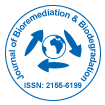开放获取期刊获得更多读者和引用
700 种期刊 和 15,000,000 名读者 每份期刊 获得 25,000 多名读者
索引于
- CAS 来源索引 (CASSI)
- 哥白尼索引
- 谷歌学术
- 夏尔巴·罗密欧
- 打开 J 门
- Genamics 期刊搜索
- 学术钥匙
- 期刊目录
- 研究圣经
- 中国知网(CNKI)
- 乌尔里希的期刊目录
- 访问全球在线农业研究 (AGORA)
- 参考搜索
- 哈姆达大学
- 亚利桑那州EBSCO
- OCLC-世界猫
- SWB 在线目录
- 普布隆斯
- 日内瓦医学教育与研究基金会
- 米亚尔
- ICMJE
有用的链接
开放获取期刊
分享此页面
抽象的
Optimization of pH, Retention Time, Biomass Dosage in Beads and Beads Density on Textile Dye Effluent Bioremediation using Seagrass, Cymodocea rotundata Beads
Soumya GN, Manickavasagam N, Santhanam P, Dinesh Kumar S, Vasanthi D and Karuppasamy PK
Laboratory experiments were performed to study the removal of dye from textile effluent using the seagrass Cymodocea rotunda beads in calcium alginate. The present experiment was conducted to know the effects of pH, beads density, retention time and biomass dosage in beads on dye removal from textile effluent. Algal uptake and adsorption on alginate gels were the major principals involved in the removal of nitrate and phosphate from effluent. Increasing cell stocking in beads did not cause any improvement in the efficiency of treatment, but caused some leakage problems. Also, the increased beads concentration in effluent caused reductions in light penetration and enhanced self-shading effects besides the beads settled at the bottom of the reactor. The experiment inferred that the 75 numbers of algal beads with pH 8 in the biomass dosage of 0.1 g and 120 minutes retention time were found to be suitable factors for the effective removal of dye from the textile effluent.

 English
English  Spanish
Spanish  Russian
Russian  German
German  French
French  Japanese
Japanese  Portuguese
Portuguese  Hindi
Hindi